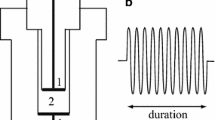Summary
The fusion of human cells of the cerebrospinal fluid and of the peripheral blood is reported, as well as the fusion of these cells with tomato protoplasts. The cells were fused by applying short-time electric pulses after dielectrophoretic collection. The importance of this method for diagnosis and therapy is discussed and possible applications are mentioned.
Similar content being viewed by others
References
Baehr R von (1985) Die medizinische Bedeutung induzierter monoklonaler Antikörper — Ursprung, Stand und Perspektiven. Z Klin Med 40:85–94
Dommasch D (1975) Monocytes and histiocytes in cell cultures of cerebrospinal fluid. J Neurol 209:103–114
Dommasch D, Grüninger W, Schultze B (1977) Autoradiographic demonstration of proliferating cells in cerebrospinal fluid. J Neurol 214:97–112
Dudits D, Rasko I, Hadlaczky Gy, Lima-De-Faria A (1976) Fusion of human cells with carrot protoplasts induced by polyethyleneglycol. Hereditas 82:121–124
Guseo A (1971) Der Untergang der Liquorzellen in vivo und in vitro. Ideggyòg Szele 24:471–479
Jacob HE, Siegemund F, Bauer E (1984) Fusion von pflanzlichen Protoplasten durch elektrischen Feldimpuls nach Dielektrophorese. Biol Zentralbl 103:77–82
Küppers G, Diederich KJ, Zimmermann U (1984) Fusion by stimulated atmospheric discharges: further support for the hypotheses of involvement of electrofusion in evolution. Z Naturforsch 39:973–980
Lamprecht I, Mischel M (1981) Dielektrophoretische Untersuchungen an biologischen Systemen. Naturwissenschaften 68:501–506
Lo MUS, Tsong TY, Conrad MK, Strittmatter MS, Hester LD, Snyder SH (1984) Monoclonal antibody production by receptor-mediated electrically induced cell fusion. Nature 310:792–794
Müller W (1967) Über die Methodik der Liquorzellkultur. Ber Dtsch Phys Med Ges Würzburg 74:15–18
Müller W (1970) Beobachtungen an lebenden Liquorzellen unter Gewebekulturbedingungen. Z Neurol 198:315–331
Müller W, Versteeg J, van der Kuip L (1972) Die Kombination von Liquorzellkultur und Immunofluorescenz als diagnostische Methode. Z Neurol 202:159–163
Neumann E, Rosenheck K (1972) Permeability changes induced by electric impulses in vesicular membranes. J Membr Biol 10:279–290
Scheurich P, Zimmermann U (1981) Giant human erythrocytes by electric field-induced cell to cell fusion. Naturwissenschaften 68:45
Schmidt RM (1968) Der Liquor cerebrospinalis. VEB Volk und Gesundheit, Berlin
Schreier H (1982) Liposomen — ein neuartiger Arzneistoffträger. I. Phospholipide: Herstellung und Charakterisierung von Liposomen. Pharm Unserer Zeit 11:97–102
Schreier H, Raeder-Schikorr M (1982) Liposomen — ein neuartiger Arzneistoffträger. II. Schicksal von Liposomen in vivo: Einsatz in der Therapie. Pharm Unserer Zeit 11:103–108
Siegemund F, Golze P (1982) Effects of some conditions for the isolation of viable protoplasts of tomato, Lycopersicon esculentum Mill. Biològia (Bratisl) 37:1095–1102
Siegemund F, Tschuch G (1984) Elektrisch induzierte Fusion von Lycopersicon-Protoplasten unterschiedlicher Herkunft. Arch Züchtungsforsch 14:163–168
Vienken J, Zimmermann U, Alonso A, Chapman D (1984) Orientation of sickle red blood cells in an alternating electric field. Naturwissenschaften 71:158–159
Wieczorek V (1969) Klinische und tierexperimentelle Liquorzelluntersuchungen zur differentialdiagnostischen Abgrenzung und Bedeutung der einzelnen Zellarten im Liquor cerebrospinalis für die Diagnostik bei Erkrankungen im Bereich des ZNS. Habilitation thesis, Jena
Zimmermann U (1982) Electric field-mediated fusion and related electric phenomena. Biochim Biophys Acta 694:227–277
Zimmermann U, Pilwat G, Richter HP (1981) Electric-field-stimulated fusion: increased field stability of cells induced by pronase. Naturwissenschaften 68:577–578
Zimmermann U, Scheurich PS, Pilwat G, Benz R (1981) Zellen mit manipulierten Funktionen: Neue Perspektiven für Zellbiologie, Medizin und Technik. Angew Chem 93:332–351
Zimmermann U, Vienken J, Pilwat G (1984) Electrofusion of cells. In: Chayen J, Bitensky L (eds) Investigative microtechniques in medicine and biology, vol. 1. Dekker, New York Basel
Zimmermann U, Vienken J, Pilwat G, Arnold WM (1984) Electrofusion of cells: principles and potential for the future. In: Pethica B, Whelan J (eds) Cell fusion. Pitman, London
Author information
Authors and Affiliations
Additional information
Dedicated to Professor H. Rennert on the occasion of his 65th birthday
Rights and permissions
About this article
Cite this article
Neumann, V., Siegemund, F. & Baeßler, B. Electrically induced fusion of different human cell types. J Neurol 233, 153–156 (1986). https://doi.org/10.1007/BF00314422
Received:
Revised:
Accepted:
Issue Date:
DOI: https://doi.org/10.1007/BF00314422




